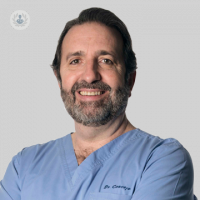Sleep apnea
Written by:What is sleep apnea?
Sleep apnea is a disorder that occurs during sleep. It consists of the patient's airway collapsing for at least 10 seconds preventing the entry of oxygen into the lungs and therefore oxygen in the blood decreases and the patient's sleep is not repairing.
What are the consequences?
The consequences of sleep apnea are due to the 2 phenomena that it produces, on the one hand a non-restful sleep and on the other hand the decrease of oxygen in the blood during sleep. Due to unrefreshing sleep the patient wakes up with a feeling of not having rested well and has a tendency to fall asleep during the day in situations such as driving, which is a danger to the rest of the users, watch TV, etc.. On the other hand the decrease in oxygen in the blood, causes the heart to have to make an overexertion and this is manifested in an increase in blood pressure and an increased risk of heart attacks and strokes, having a mortality four times higher than patients that do not suffer from apnea.
How is sleep apnea diagnosed?
The diagnosis of sleep apnea initially is a diagnosis of suspicion in patients who are very sleepy during the day, who have not rested well, and a strong snoring. But the only way to accurately diagnose a sleep apnea is to do an examination during the night through a system called polysomnography. This system interprets a lot of parameters such as the electroencephalogram during sleep, the respiratory movement of the rib cage, the heartbeat and the saturation of oxygen in the blood. With all these parameters we can know how many pauses of apnea a patient has had at night and how far his oxygen level in the blood has dropped and in this way to determine if the sleep apnea is mild, moderate, severe or if not there is sleep apnea.
What is the treatment?
The treatment of sleep apnea is to avoid those pauses of apnea that occur during the night and for that we have a device called CPAP which does is to introduce air to a high pressure in the airway and prevents it from collapse in no time. This device is connected to the patient through a mask and you have to sleep with it throughout the night and every day logically, that way we will avoid that patient having amnea.

Is there any definitive treatment?
Yes, there are logically treatments that are curative of sleep apnea. We reserve them for patients who do not want to live their entire lives depending on a machine such as CPAP or for patients who simply can not tolerate it, because they can not breathe well with the device in place or simply can not sleep with it.. These treatments basically what they do is expand the airway acting at two levels. On the one hand, we have a type of operations that act on the soft parts of the airway such as the palate, the turbinates, the nasal septum or the base of the tongue. This type of surgeries are simple surgeries that are often performed with local anesthesia and sedation and with a fast recovery of 4 or 5 days. However, it is not always effective and in the most serious cases we need to do another type of intervention that consists of cutting the bones of the face and overtaking them in such a way that we can increase the airway very significantly.. This type of operations is always performed under general anesthesia. It is an operation that lasts between 2 and 3 hours and, although it seems something very spectacular, the recovery of patients is quite fast, being able to reincorporate to their normal life in a period that ranges between 7 and 15 days.


